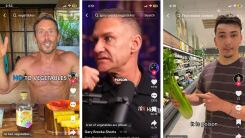TikTok Myth of the Week: Vegetables Are Bad for You

In the wellness world, things you’ve already heard are boring. Why would you want to hear yet another person tell you something you’ve heard a million times: that almost any exercise can be good, that a healthy diet includes a variety of foods including vegetables, and so on? It’s much more interesting to watch somebody tell you secrets that mainstream medicine doesn’t want you to know.
On TikTok, a bunch of (mostly) white (mostly) dudes proudly announce they don’t eat their vegetables, and you shouldn’t either. Ready to dig in?
Why TikTokers say vegetables are bad for you
Here is a little story that has a few grains of truth to it. Vegetables are plants, specifically the roots, stems, leaves, and (arguably) seeds of those plants. Plants don’t want to be eaten. So they make toxic compounds, the better to kill off anyone who tries to eat them–including you.
This talking point is parroted from video to video, and the TikToker usually follows it up with examples of specific toxins, health conditions, and vegetables that you must avoid if you want to be healthy. Sometimes they will also use the term “anti-nutrients,” a category that does not necessarily overlap with those toxins, but we’ll get to specifics in a bit.
(The TikTokers tend to forget that any relationship between an eater and an eat-ee, in nature, is an arms race. The plant evolves a toxin; the plant-eater evolves resistance to that toxin. Have they never planted a garden and watched it feed all the neighborhood insects, slugs, and squirrels? Do they think we are more fragile than insects, slugs, and squirrels? I have so many questions.)
Sometimes there will be an acknowledgement that “some” people can eat vegetables and be healthy, but that anybody whose health is imperfect should simply stop eating most or all veggies. Fruits are sometimes demonized as well, although there are also TikTokers who say they will eat fruits but not vegetables.
Are vegetables actually bad for you?
What? No! Of course not! Mountains of scientific evidence back up the idea that the more vegetables you eat, the better.
These studies have their drawbacks, as all studies do: they are mainly observational, and they combine many types of vegetables and different ways of measuring them. But even so, the results consistently and overwhelmingly point to vegetables reducing our risk of many health conditions.
For example, a 2022 study designed to evaluate the evidence behind vegetable recommendations found that eating about 12 ounces of vegetables per day, compared to eating none, reduces the risk of strokes, coronary heart disease, and esophageal cancer. This 2008 study found that people who eat at least three servings of vegetables a day reduce their risk of coronary heart disease by 70%. (There was also a 60% reduction from five servings of fruit.)
And this 2017 meta-analysis found that the more fruits and vegetables you eat, the lower your risk of the above chronic diseases and cardiovascular disease, cancer, and all-cause mortality. The more fruits and vegetables people eat, the better, they found, up to about 600 grams for cancer prevention and 800 grams for everything else. To put that in real-world terms, 800 grams of vegetables is 28 ounces, or about five to seven servings of fruits and veggies per day.
So what’s the deal with these supposed toxins and anti-nutrients?
Two things are true at the same time: yes, there are toxins and anti-nutrients in vegetables. And, they are not harmful enough to matter to us in normal quantities and with normal food preparation techniques.
As the above studies on vegetables and health show, the good outweighs the bad. People don’t get sicker the more vegetables they eat; they are healthier. You don’t need to dig into the specifics of what lectins or sulforaphanes or tannins do to our body to know that the big-picture answer is that we should be eating our veggies.
But I know you want to hear the details, so let’s take a look at a few of the big names in anti-vegetables TikTok.
Lectins
Lectins are plant proteins that bind to carbohydrates. They can prevent absorption of some nutrients, and can sometimes cause gastrointestinal illness. For example, there are dozens of case reports of people developing vomiting and diarrhea from lectin poisoning after eating undercooked kidney beans. This is why it’s important to boil your beans for 10 minutes, instead of simply soaking and slow cooking. (Canned beans have already been cooked enough to destroy the lectins.)
As Harvard’s Nutrition Source explains, “It is important to remember that eating foods with a high amount of active lectins is rare.” Cooking destroys or significantly reduces the lectin content in foods. It’s unlikely that you’re even getting much lectin content in your food at all.
The TikTokers who say that lectins can cause gastrointestinal issues aren’t speaking from clinical evidence; aside from cases where people overdosed on lectins (like the kidney bean poisoning), most of our evidence is from studies that don’t involve humans or the kinds of vegetables humans routinely eat. Is it possible that some people are sensitive to the effects of certain lectins? Sure. But are lectins found in vegetables ruining our health in any kind of universal or widespread way? It’s pretty clear they are not.
Lectins also have their upsides: they are antioxidants, and can also slow the absorption of carbohydrates, potentially helping to avoid blood sugar spikes after eating. Foods that contain lectins include legumes (beans, lentils) and whole grains. These foods contain fiber, vitamins, and other healthful components, and there’s plenty of evidence that overall, these foods are good for us.
Oxalates
We’ve long known that it’s bad to eat large doses of foods that are high in oxalates or oxalic acid; that’s why, when you buy rhubarb at the grocery store, the red stalks don’t come with leaves attached. Rhubarb leaves are notoriously high in oxalates. Other vegetables, mainly leafy greens like spinach (but also potatoes!), contain oxalates in smaller amounts.
But, again, most of our grocery-store vegetables don’t contain enough oxalates to be a health issue. Cooking reduces the oxalate content further. If you have a history of oxalate-containing kidney stones, the American Urological Association suggests that you might want to limit high-oxalate vegetables. (Not avoid them entirely, as TikTokers would suggest, but simply enjoy them in small doses.)
You see how the risks sound a lot different when you listen to TikTok rants versus getting your information from medical sources. TikTok told me that oxalates cause kidney stones and kidney failure; Colorado State University’s nutrition center told me that the oxalate in most kidney stones is manufactured by the body itself, that drinking plenty of water is the best nutrition-based tip for avoiding kidney stones, and that “it is recommended to include many oxalate-containing plant foods in the diet as evidence suggests that these foods play a vital role in disease prevention.”
Toxic reactions to vegetables look pretty different than what TikTok wants us to believe
The sweet spot for TikTokers, medically speaking, is when you feel kind of yucky and aren’t sure why. Then you’ll try their diet, or their supplements, or at least keep watching their content and boosting their engagement metrics.
In reality, there are plenty of opportunities for us to have bad reactions to toxic compounds in vegetables, with dramatic results that would lead you to seek immediate medical attention–and this is exactly why the FDA, the WHO, and other organizations warn against exposing ourselves to the dangerous ones. They want us to be sure that we fully cook our kidney beans, that we don’t eat rhubarb leaves, that we avoid honey made from mountain laurel and rhododendron flowers, and that we don’t eat peach pits or apple seeds. (Re: the latter, “accidentally eating a seed or pit will not harm you,” but please don’t eat them in large amounts.)
TikTokers can, of course, attempt to weaponize this information to scare us away from perfectly harmless vegetables. For example, one video states that celery is poison because it contains an acid that makes you susceptible to sunburn. The part about sunburn is true! (The part about poison is not.) Celery juice can sensitize your skin to UV exposure; so can lime juice, causing the reaction nicknamed “margarita hand.” A woman developed a severe reaction when she ate an entire pound of celery before heading to the tanning salon. This does not mean you need to avoid celery entirely.
Nor should you believe the videos from a sea moss supplement company that say celery’s acidic pH indicates it is man-made and not from nature (huh?) or that broccoli gets stuck in our digestive system for up to 4 weeks if we do not purchase sea moss supplements. (This is the 100-year-old “your guts are full of stuck poop” myth all over again.)
Meanwhile, many of the compounds that TikTokers demonize–including tannins, sulforaphanes, and glycoalkaloids–seem to have beneficial effects as well as potentially harmful ones. Here’s an article from the M. D. Anderson Cancer Center recommending that we seek out cruciferous vegetables specifically for their sulforaphane content.
In conclusion, vegetables are still good for us, no matter what TikTok says. I won’t make you eat them–I’m not your mom–but please don’t believe the online fearmongering.



